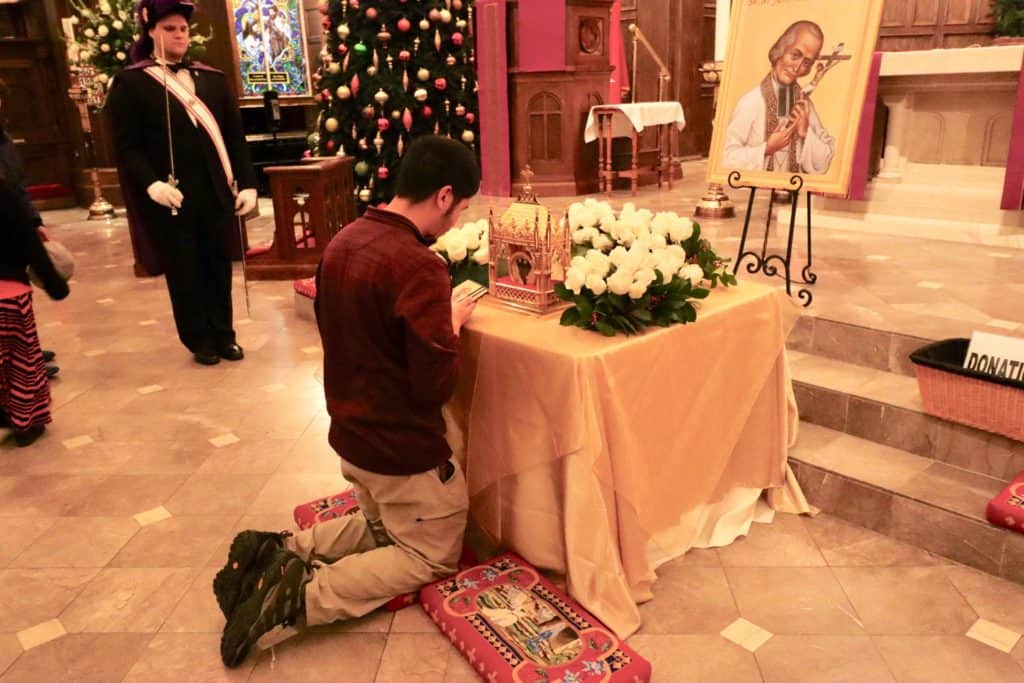Going on pilgrimages involve going to sacred sites as part of a religious devotion or goal. Sometimes these sacred sites are also where people can visit relics.
Relics and pilgrimages go well hand in hand because major shrines and churches often house significant relics. Relics also connect us to the past or tangibly help us remember about holy people or things.
Let’s dive deeper into relics!
So then, what are relics?
According to Fr. Hardon’s Modern Catholic Dictionary (2008), a relic is “an object connected with a saint, eg., part of the body or clothing or something the person had used or touched” (p. 461). You cannot buy or sell relics.
Relics can range from the actual flesh and bones of holy people, and things that these people have frequently interacted with. Another kind of relic are objects that have touched either those previous categories. Sometimes you’ll hear these categories as a “class” of relics. Here’s a summary:
- First Class = an actual part of a saint’s body
- Second Class = clothing or an object used during the saint’s life
- Third Class = an object, usually cloth, that has been touched to a first-class relic
Another vocab word to know is “reliquary”. A reliquary is an object that holds or contains a relic.
What does it mean to venerate relics?
The proper response to encountering relics is to venerate them. We do not worship relics nor the holy people that they come from.
To venerate is to honor, but not in the same way God Himself is honored. You can venerate a relic by treating the relic with respect, maintaining a prayerful attitude, remembering the person the relic comes from, and asking for that person’s intercession.
Asking for the intercession of holy people is legit because we’re pretty darn sure that they’re in heaven, especially if they are a canonized saint. Their relics are a tangible way to connect us to them.
Other ways to venerate a relic is to kiss or touch the (glass of the) reliquary, making the sign of the cross, or kneeling before it in prayer. However, I again stress that these actions are done out of love for the saint as a way to encounter God and not done out of worship of the person.
Why are relics important?
Relics are important because they remind us of our earthly pilgrimage to heaven. Relics are of holy people who have passed on to eternal glory, and they remind us of the lives and stories of those who lived a life of holiness pursuing God. The relics we have of saints show us that we, too, can reach sanctity.
Relics also remind us of the resurrection. We don’t treat the remains of people lackadaisically because that would be disrespectful. We await the Second Coming of Christ and to be resurrected with Him, and relics help illustrate that reality.
Where can I find relics?
Most churches will actually have a relic of a saint in the altar, especially if that church is named after a particular saint. But that’s not always the case.
If a saint is associated with a particular place or buried somewhere, their relics will usually be in a church, shrine, or chapel.
A good example would be the city of Rome. With so many saints associated with Rome ranging from early Christian martyrs to more contemporary individuals, it’s pretty easy to find a church or shrine housing the relics of a saint.
Sometimes the relics of a saint are scattered geographically. For example, St. Catherine of Siena’s skull is in Siena, but the rest of her body rests in Rome. St. Francis Xavier’s arm is in Rome, but his body is in India. Even in Rome, St. Peter is buried inside St. Peter’s Basilica in the Vatican, but his skull is at St. John Lateran (along with St. Paul’s skull).
Some places around the world also have collections of relics. I know that St. Anthony’s Chapel in Pittsburgh, PA has the largest collection of relics in the United States.
And lastly, sometimes relics go on tour. Relics go on tour for the faithful to venerate. In North America, I know that the relics of St. Maria Goretti, St. Padre Pio, St. Francis Xavier, and St. John Vianney have passed through.
Cool and Weird Examples of Relics
I’ve been all over the place, and I’ve encountered some weird and cool examples of relics.
Most recently, I went on a pilgrimage to Atlanta, GA to venerate the heart of St. John Vianney, a French priest from the 1800’s. Amazingly, his heart is still preserved, which makes sense because he had such a heart for his priestly ministry. See featured photo.
I’ve encountered vials of Pope St. John Paul II’s blood in reqliuaries inside of the John Paul II Shrine in Washington, DC, JP2 University in Escondido, CA, and North American College in Rome. Weird, but cool.
When I was in Japan, I was before the very bones of St. Paul Miki and his companions in Nagasaki inside St. Philip’s. 26 of them were martyred on a hill via crucifixion, where the Museum and St. Philips now stand, during Japan’s isolation period and Christian persecution.
I’m a Knight of Columbus, and Fr. McGivney was our founding Father, as it were. I went to go visit the church where he started the Knights, and in the corner of the church is an above-ground stone tomb where he is buried. He’s not a canonized saint…yet.
In Washington, DC at the Franciscan Monastery of the Holy Land, they have the body of St. Innocent, a child martyred in Rome from the early centuries.
While praying in front of an abortion clinic, visiting a church in middle-of-nowhere north Texas, and in an obscure church in Rome, I’ve visited relics of the True Cross—(supposedly) pieces of the very wood that our Lord was crucified on.
Also in Rome and related to the True Cross, I’ve visited relics related to Jesus’ Passion including thorns from His crown of thorns, one of the nails that pierced Him, and part of the INRI sign. They’re found in an unassuming basilica down the street from St. John Lateran at the Basilica of the Holy Cross in Jerusalem.
I’m sure there’s more, but lastly, I’ve also visited the relic of the manger—the food trough that Jesus was laid in after being born. It’s inside of St. Mary Major in Rome.
A last note—St. John Vianney’s heart and St. Innocent, mentioned above, are of a category of relics we call “incorrupt”. Being incorrupt basically means that the relic has not undergone expected decay. It’s pretty wild, dare I say miraculous! St. Innocent lived over 1500 years ago, but you can still see his hand with flesh. St. John Vianney’s heart, though black, is still intact despite being over 150 years old. Even his body is incorrupt.
The most dramatic examples of incorrupt relics are the full bodies of saints who are very much dead in the flesh, but look like they’re sleeping. See St. Bernadette.
Bottom Line
I could probably go on and on about relics! There’s so much to unpack and so many more weird and crazy examples.
Ultimately, visiting relics is a great excuse to go on pilgrimages! Relics are not for worshipping others, but rather, they help us remember our call to holiness and that there are very real people who have lived out this call.
Question for you—what’s a relic you’ve recently visited? Let me know in the comments!
References
Hardon, John A., S.J. (2008). A Modern Catholic Dictionary. Bardstown, KY: Eternal Life.
Featured photo courtesy of Light & Heavy.

JR is a full-time engineer working in the aerospace industry. Apart from having such a fly job, he flies unto the arms of Our Lady and the Church pursuing his faith and a relationship with Christ. Over the past several years, faith and flying via pilgrimages became a thing. When he’s not being fly, JR hangs out with family, friends, his chihuahua, and with thoughts of the next trip.


Incredible!! All of it!! I don’t think our family has any relics!! I will have to find one! I am going to print this off for the kids….you summed it up perfectly!! Thank!
Thanks for the feedback! And yeah! I haven’t heard about it in a while, but I know someone at the parish has a room full of third class relics!